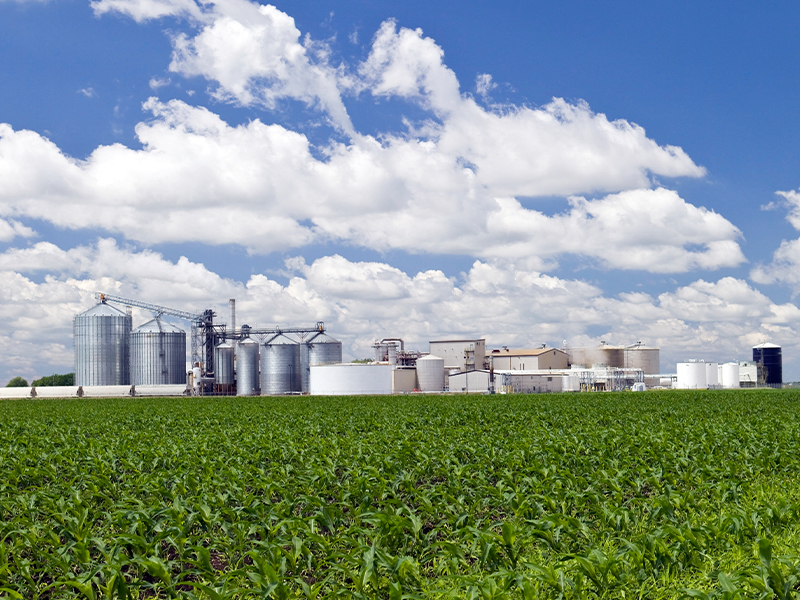A biofuels facility in the Midwest United States implemented an integrated Zero Liquid Discharge (iZLD) solution developed by Kurita America that significantly reduced water intake for ethanol production, enabling the facility to expand production while meeting plant integrity and environmental compliance needs. This holistic approach took into consideration all aspects of the facility – chemistry, engineering, equipment and service – to develop a cost-efficient solution that also reduces discharges.
Challenged by a limited municipal water supply, the biofuels facility was already operating at its permitted water capacity of 750 gallons per minute. In order to expand production, facility managers knew they had to find a way to increase available water by 30 percent, so they contacted Kurita America to help them determine their options.
Over a period of approximately four months, the Kurita America team held multiple meetings with key stakeholders and partners to gain a deep understanding of facility operations, current challenges and potential options. From these meetings, the team strategized different scenarios and mapped various protocols by asking questions such as:
- What can be done to minimize the plant’s current water footprint?
- Where does the water need to go and return to?
- What equipment is involved as far as upgrades to current equipment?
- Should new equipment be added to get water where it needs to go?
Kurita America also scheduled numerous round-table discussions with its own internal equipment and technical experts and the biofuels facility staff to determine the best possible solutions, carefully considering multiple factors raised by all involved.
Local water quality and availability has an enormous impact on how complex the system will need to be to accomplish these reduction goals. Therefore, an understanding of plant chemistry and operations in ethanol production is key to identifying an economical and efficient iZLD solution. The quality of the water – whether sourced from municipality or an onsite well – affects the plant in several areas: for example, sodium affects yeast health and chloride impacts asset integrity. Also, higher mineral content in water cycled in the cooling tower could create scaling issues or increase overall water usage due to lower cycles or using Reverse Osmosis (RO) permeate as make-up.
The Kurita America team first explored the option of drilling a new well on the facility site to increase water supply. However, this option was eliminated when they determined that the quality of the groundwater, which contained high levels of calcium, iron and sulphate, made it too costly to use without having to invest an estimated $1 million.
The Kurita America team worked with the biofuels plant’s fermentation/process team to make sure the reuse water would not result in any negative effects on efficiency and yield.
Kurita America developed an iZLD solution that reduced the volume of freshwater brought into the plant by 100 gallons per minute (worth over $200,000 annually), at the same time eliminating water discharge from the plant. By freeing up more water, the plant can now use this extra water to increase production (20,000,000 gallons of ethanol) and annual revenue by approximately $27 million in increased ethanol sales.
Treatment goals are often achieved by combining precipitation and filtration processes or integrating both chemical and equipment solutions. In this application, the Kurita America team accomplished its goal by finding creative ways to reuse water from one application in another, without the need for additional equipment. Our “out-of-the-box” solution focused on maximizing the cooling tower cycles and RO recovery rate in order to minimize water usage, then reusing both the blowdown and RO concentrate in the plant.
Kurita America Industry Consultant, Lyle Bennet said: “Instead of selling additional water treatment equipment, we modified the water balance – how water is used in the plant – with a couple poly tanks, forwarding pumps and some piping modifications. We were asked to reduce water intake and water usage by gallons per minute – and we delivered.”
Consequently, the iZLD solution “freed up” more water enabling the biofuels facility to increase ethanol production, which required more water for use in processing, cooling tower and boiler.
Following the successful rollout of the iZLD solution, the Kurita America team continues to monitor and track progress and make adjustments to improve operations when necessary. In addition, a local representative performs routine onsite visits to ensure that all aspects of the water-related operations in the facility work effectively.
The holistic iZLD solution improved the overall efficiency of the biofuels facility because it reduced water intake, increased available water and eliminated all water discharge from the ethanol production plant. As a result, facility managers no longer need to address potential discharge permit challenges, which can often significantly slow down production.

